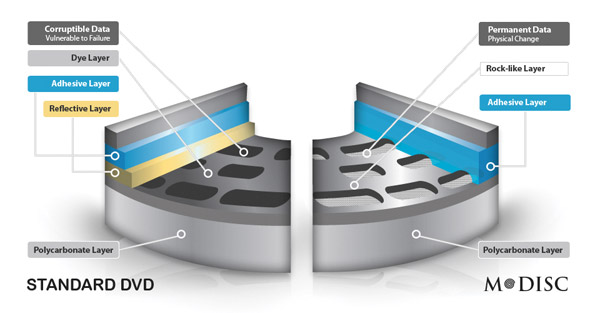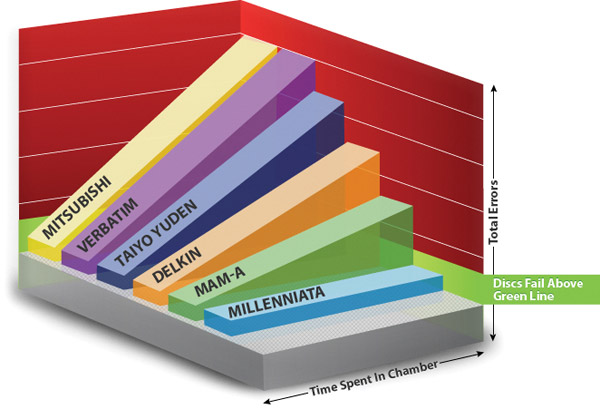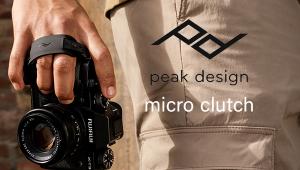Millenniata Discs: “More Than” Archival Storage On American-Made DVDs
I often get questions about how to store digital image files safely and securely. Although there have been a lot of options, all of them have involved compromises. Recently, however, one of our readers told me about Millenniata.com, and I immediately looked into this new American company. I found that Millenniata has a new DVD disc technology that provides “more than” archival life expectancy, as established by the US Department of Defense’s Naval Air Warfare Center Weapons Division at China Lake, California. Their report can be downloaded as a PDF file from the Millenniata website.

Photos courtesy of Millenniata
The Millenniata DVD product is called an M-Disc. It is the same size as a typical DVD and will run and read with most DVD drives, but it looks very different. It is a clear, see-through grayish disc, looking much like a neutral density filter. A special drive is required to record M-Discs; it’s made by LG Electronics. The one that was loaned to me is an LG BE12LU30 with a list price of $159. This external drive is the top-end of the selection of LG drives that will be available to record M-Discs. Less expensive versions that do not support Blu-ray should be about the same cost as current LG drives. The one I used was very quiet and smooth, one of the best DVD/CD drives I have used. Both the drives and the M-Discs, which will sell for about $3 each, will be available through the Millenniata website as well as many independent dealers in the near future.

Although the technological description of the Millenniata system is very general, the company calls the M-Disc’s recording layer material “stone-like.” It is obvious when looking at the M-Disc that the recording layer is not a dye material with a reflective layer, like standard DVD/CD discs.

According to Millenniata, the recording material in their disc is a combination of metals and inorganic material in a thin nano-scale layer that is resistant to oxidation. And, with a polycarbonate base, the stability of the M-Disc and its recorded content is reasonable.

The Department of Defense’s China Lake report assures the Millenniata concept meets demanding practical tests. Other details are somewhat scant, but I can’t blame the company for being a little vague and secretive about what their product is and how it works. I am sure many competitor disc manufacturers will try to do something similar. The new LG drives are also basically like other DVD/CD drives and will record and play current standard media discs as well as the M-Disc very effectively.

I am sure some will wonder if photographic image files recorded on an M-Disc will be in any way affected in content or quality by this different media. I was provided samples of the M-Disc and used the LG drive to record a large number of digital photo files on the discs. I played the discs with a variety of different drives, and only one independently made external drive did not recognize the M-Disc to access and read the data. This did not concern me as that drive is one I have used to burn hundreds of CD-R discs, and I have seven other drives that worked 100 percent normally with the M-Disc. Checking the files recorded on the M-Disc against the originals, I could not find any differences in the content.

Conclusion & Recommendation
DVD-R and even more CD-R technology has been long established, with little variation in products for some years, so there may seem to be a reason to wonder why an archival product has not been available until now. The reason might be that those who need long-lasting personal storage, like photographers, are a really small niche group in a much larger market population. In other words, there may not have been enough of us with the need for archival storage to make an attractive market. That a company in America did see the need and found a solution makes it quite attractive.


Photos © David B. Brooks
Considering the investment, especially if not a Blu-ray drive, is modest and the $3 M-Disc cost is also competitive with a standard DVD-R, it is not a great risk, so anyone who wants their photographic files preserved for those in the future is not held back by cost. Even without the Department of Defense’s testing and favorable report, I would take Millenniata seriously. By the time I use up my stock of gold-gold CD-R discs, I will be ordering an LG drive and a supply of M-Discs.
For more information on the M-Disc, visit www.millenniata.com.

















































